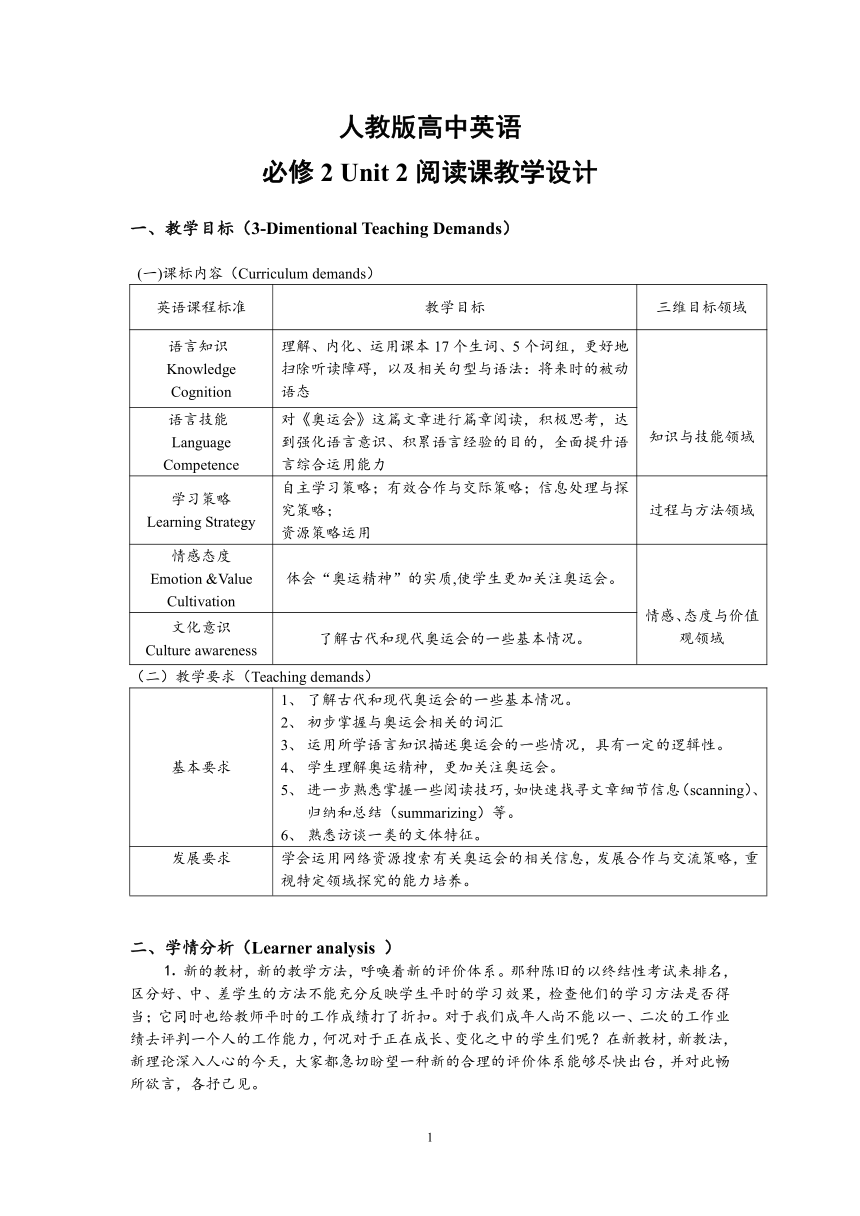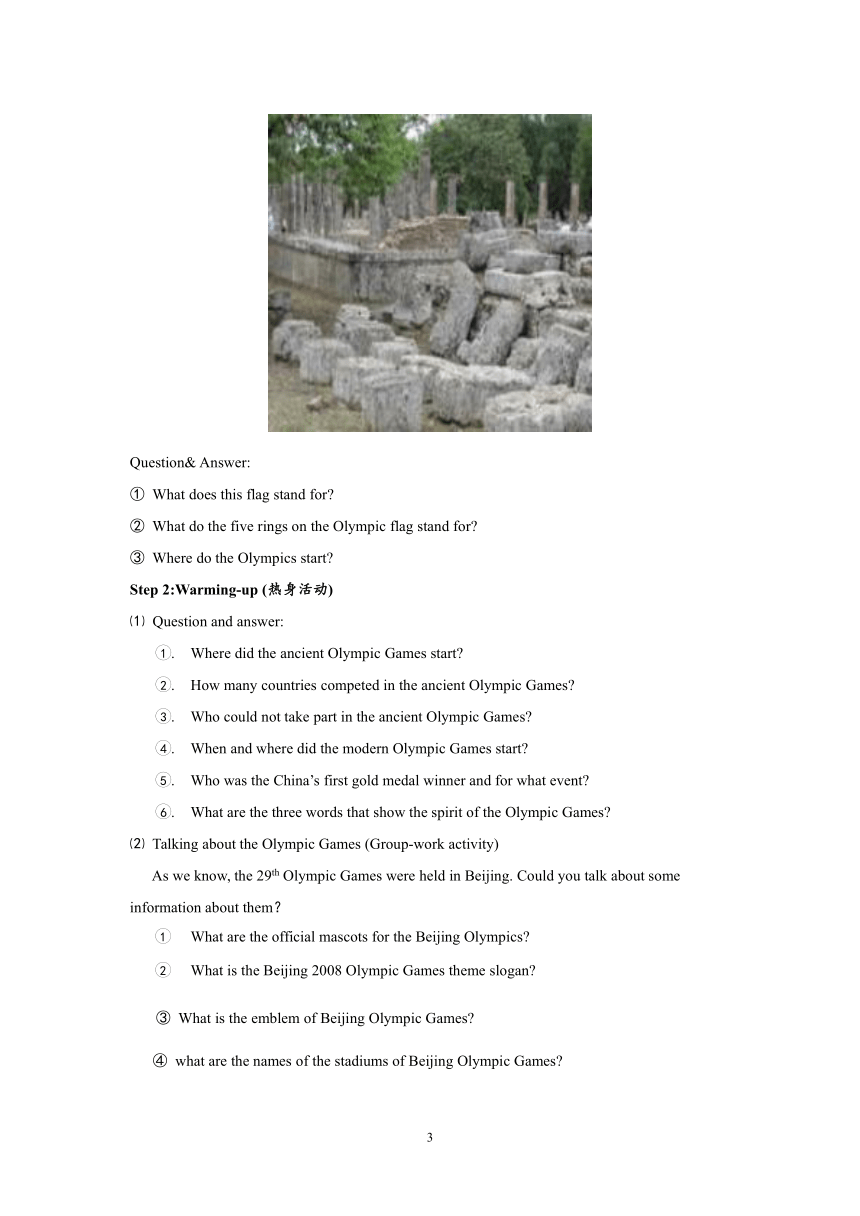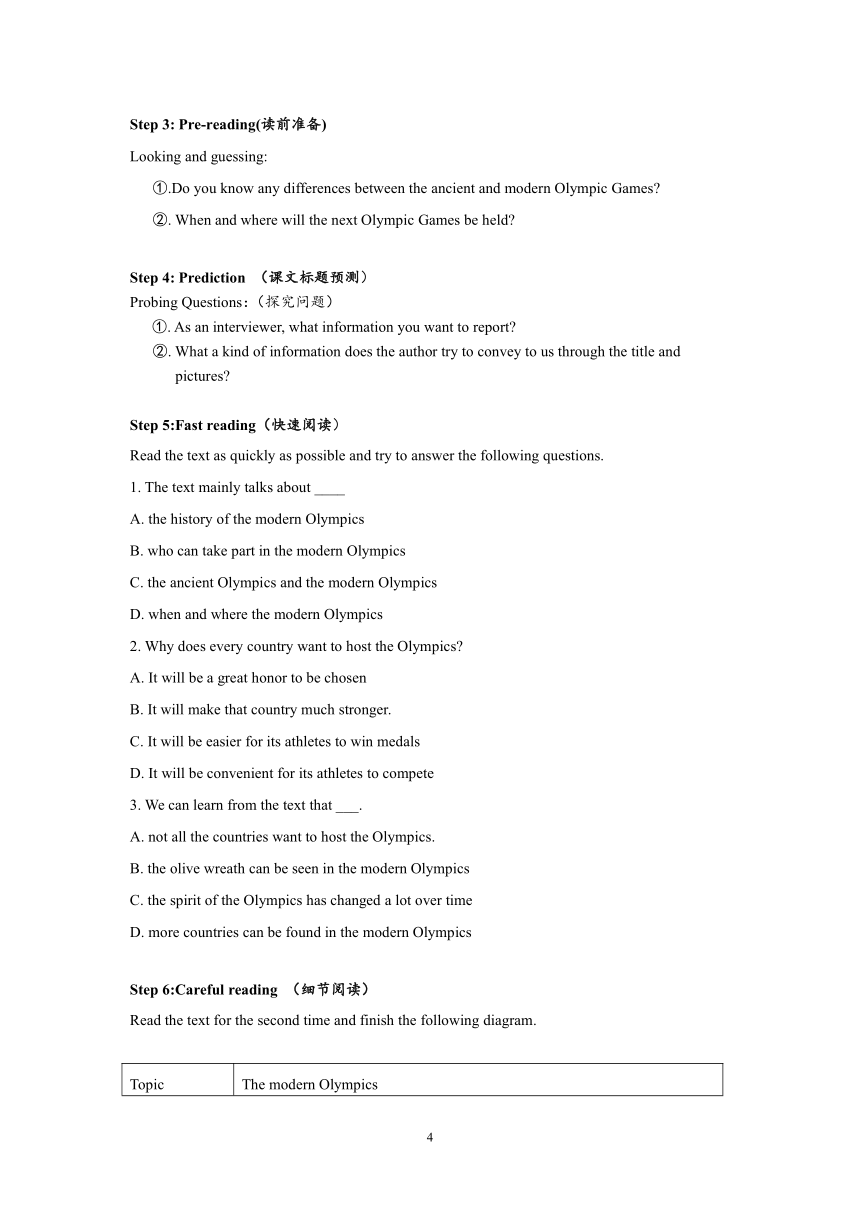人教版(新课标)高中英语必修二 Unit 2 The Olympic Games教案: 阅读课教学设计
文档属性
| 名称 | 人教版(新课标)高中英语必修二 Unit 2 The Olympic Games教案: 阅读课教学设计 |

|
|
| 格式 | zip | ||
| 文件大小 | 269.0KB | ||
| 资源类型 | 教案 | ||
| 版本资源 | 人教版(新课程标准) | ||
| 科目 | 英语 | ||
| 更新时间 | 2021-03-26 12:38:11 | ||
图片预览





文档简介
人教版高中英语
必修2
Unit
2阅读课教学设计
一、教学目标(3-Dimentional
Teaching
Demands)
(一)课标内容(Curriculum
demands)
英语课程标准
教学目标
三维目标领域
语言知识Knowledge
Cognition
理解、内化、运用课本17个生词、5个词组,更好地扫除听读障碍,以及相关句型与语法:将来时的被动语态
知识与技能领域
语言技能Language
Competence
对《奥运会》这篇文章进行篇章阅读,积极思考,达到强化语言意识、积累语言经验的目的,全面提升语言综合运用能力
学习策略Learning
Strategy
自主学习策略;有效合作与交际策略;信息处理与探究策略;资源策略运用
过程与方法领域
情感态度Emotion
&Value
Cultivation
体会“奥运精神”的实质,使学生更加关注奥运会。
情感、态度与价值观领域
文化意识Culture
awareness
了解古代和现代奥运会的一些基本情况。
(二)教学要求(Teaching
demands)
基本要求
了解古代和现代奥运会的一些基本情况。初步掌握与奥运会相关的词汇运用所学语言知识描述奥运会的一些情况,具有一定的逻辑性。学生理解奥运精神,更加关注奥运会。进一步熟悉掌握一些阅读技巧,如快速找寻文章细节信息(scanning)、归纳和总结(summarizing)等。熟悉访谈一类的文体特征。
发展要求
学会运用网络资源搜索有关奥运会的相关信息,发展合作与交流策略,重视特定领域探究的能力培养。
二、学情分析(Learner
analysis
)
⒈
新的教材,新的教学方法,呼唤着新的评价体系。那种陈旧的以终结性考试来排名,区分好、中、差学生的方法不能充分反映学生平时的学习效果,检查他们的学习方法是否得当;它同时也给教师平时的工作成绩打了折扣。对于我们成年人尚不能以一、二次的工作业绩去评判一个人的工作能力,何况对于正在成长、变化之中的学生们呢?在新教材,新教法,新理论深入人心的今天,大家都急切盼望一种新的合理的评价体系能够尽快出台,并对此畅所欲言,各抒己见。
2.学生来自农村和城镇,英语水平参差不齐,学习压力大,学习策略与方法不合理,有的学生还不喜欢英语。这个问题值得我们引起高度重视。仍然运用以往的以考试成绩来刺激学生学习的作法显然只能是适得其反了。
三、教学重点和难点:(Teaching
difficult
and
important
points)
★教学重点:1.学生掌握本篇文章当中的单词,词组以及重要表达
Master
the
new
words,
phrases
and
useful
expressions
in
the
text.
2.学生掌握理解文章细节的阅读能力
Students
should
improve
their
ability
to
understand
the
content
of
text
in
detail.
3.学生在体验中学会与人合作的能力
Students
should
improve
their
ability
to
cooperate
with
others.
重点突破:1.任务驱动,层层深入。利用“任务驱动”方法,使学生利用资源自主探究、解决一系列层层深入的问题。在教学中,教师作为问题的精心设计者和疑难问题的点拨者,培养学生组织语言的能力。
2.借住网络,自主学习。利用直观图片激活学生的思考。
★教学难点:
1.学生在借助网络资源的基础上对奥运会及体育竞技相关知识做一了解和学习,合理运用网络将二者结合起来。
2.通过本课对奥运会相关知识的学习、强化,体会“奥运精神”的实质,更加关注奥运会,认识生活中团结协作能力的重要性。
难点突破:设置情境,循序渐进,层层递进。设置富有情趣的情境,激发他们的阅读和运用语言的欲望,积极主动的进行资助探究,循序渐进的设计问题,激发学生的创造思维,层层深入的引导学生进行自主和协作学习。
四、教学方法
(Teaching
Methodology)
根据第二语言习得理论、“整体语言教学”的理论和实践,以及当前教学改革,课程改革等先进理念,为达成上述教学目标,运用任务型教学(Task-based
teaching
mode)途径,我的英语课堂设计采取“P---T---P(Pre-task----Task-cycle----Post-task)”自主学习立体模式:
五、教学工具:
blackboard,
multimedia,
projector.
六、教学时间:45
分钟
Period
I
Warming
up
and
Reading
七.教学设计步骤(Teaching
Procedures)
Step
1:Greeting
&Lead-in
(情境导入)
⑴
Greet
to
the
students
as
usual.
⑵
Free-talk
on
picture-linking
(学生自由发言)
(Show
some
pictures)
Question&
Answer:
①
What
does
this
flag
stand
for?
②
What
do
the
five
rings
on
the
Olympic
flag
stand
for?
③
Where
do
the
Olympics
start?
Step
2:Warming-up
(热身活动)
⑴
Question
and
answer:
1.
Where
did
the
ancient
Olympic
Games
start?
2.
How
many
countries
competed
in
the
ancient
Olympic
Games?
3.
Who
could
not
take
part
in
the
ancient
Olympic
Games?
4.
When
and
where
did
the
modern
Olympic
Games
start?
5.
Who
was
the
China’s
first
gold
medal
winner
and
for
what
event?
6.
What
are
the
three
words
that
show
the
spirit
of
the
Olympic
Games?
⑵
Talking
about
the
Olympic
Games
(Group-work
activity)
As
we
know,
the
29th
Olympic
Games
were
held
in
Beijing.
Could
you
talk
about
some
information
about
them?
1
What
are
the
official
mascots
for
the
Beijing
Olympics?
2
What
is
the
Beijing
2008
Olympic
Games
theme
slogan?
③
What
is
the
emblem
of
Beijing
Olympic
Games?
④
what
are
the
names
of
the
stadiums
of
Beijing
Olympic
Games?
Step
3:
Pre-reading(读前准备)
Looking
and
guessing:
①.Do
you
know
any
differences
between
the
ancient
and
modern
Olympic
Games?
②.
When
and
where
will
the
next
Olympic
Games
be
held?
Step
4:
Prediction
(课文标题预测)
Probing
Questions:(探究问题)
①.
As
an
interviewer,
what
information
you
want
to
report?
②.
What
a
kind
of
information
does
the
author
try
to
convey
to
us
through
the
title
and
pictures?
Step
5:Fast
reading(快速阅读)
Read
the
text
as
quickly
as
possible
and
try
to
answer
the
following
questions.
1.
The
text
mainly
talks
about
____
A.
the
history
of
the
modern
Olympics
B.
who
can
take
part
in
the
modern
Olympics
C.
the
ancient
Olympics
and
the
modern
Olympics
D.
when
and
where
the
modern
Olympics
2.
Why
does
every
country
want
to
host
the
Olympics?
A.
It
will
be
a
great
honor
to
be
chosen
B.
It
will
make
that
country
much
stronger.
C.
It
will
be
easier
for
its
athletes
to
win
medals
D.
It
will
be
convenient
for
its
athletes
to
compete
3.
We
can
learn
from
the
text
that
___.
A.
not
all
the
countries
want
to
host
the
Olympics.
B.
the
olive
wreath
can
be
seen
in
the
modern
Olympics
C.
the
spirit
of
the
Olympics
has
changed
a
lot
over
time
D.
more
countries
can
be
found
in
the
modern
Olympics
Step
6:Careful
reading
(细节阅读)
Read
the
text
for
the
second
time
and
finish
the
following
diagram.
Topic
The
modern
Olympics
Two
sets
of
Games
The
_1_
and
the
Summer
Olympics,
the
former
is
usually
held
__2_
years
before
the
latter.
How
often
Every
_3__
years
The
_4__
Swifter,
higher
and
_5__
_6___between
the
two
Games
names
events
athletes
Host
countries
prizes
The
_7_
Olympics
Running
and
house
riding
Only
the
Greeks.
The
slaves
and
women
couldn’t
join
in
either.
Greece
The
_10__
wreath
The
Modern
Olympics
Running,
swimming,
sailing
and
all
the
team
sports
in
the
__8___Olympics
Athletes
reaching
the
agreed
_9__
for
their
event.
Every
country
all
over
the
world
medals
Step
7:Sentence
patterns
(句型)
Read
again
and
try
to
appreciate
the
language
of
the
passage:
1.
I
lived
in
what
you
call
“Ancient
Greece
”
and
I
used
to
write
about
the
Olympic
Games
a
long
time
ago.
2.
…,
and
both
are
held
every
four
years
on
a
regular
basis.
3.
It’s
in
the
Summer
Olympics
that
you
have
the
running
races,
together
with
the
swimming,
sailing
and
all
the
team
sports.
4.
No
other
countries
could
join
in,
nor
could
slaves
or
women!
5.
It’s
a
great
responsibility
but
also
a
great
honour
to
be
chosen.
7.
Only
athletes
who
have
reached
the
agreed
standard
for
their
event
will
be
admitted
as
competitors.
Step
8:Consolidation(课文巩固)
Filling
the
blacks
with
the
information
of
the
text:
The
Olympic
Games
are
now
the
biggest
sports
meeting
in
the
world,
which
include
the
_1__
and
the
___2____
Olympics.
Both
of
them
are
held
every
__3___
years.
The
Winter
Olympics
are
usually
held
two
years
before
the
Summer
Games.
In
the
Winter
Olympics,
there
are
__4___
and
ice
skating,
while
in
the
Summer
Olympics
there
are
____5___
sailing,
running
races
and
horse
riding
etc.
All
countries
can
take
part
if
their
athletes
reached
the
_6__
to
the
games.
Women
are
not
only
_7__
to
join
in,
but
playing
a
very
__8_
role.
They
live
in
a
special
___9___
with
a
main
reception
building,
several
__10____and
a
gymnasium.
It
is
a
great
_11__
to
host
the
Olympic
Games.
The
olive
wreath
has
been
_12__
by
medals.
But
it’s
still
about
being
able
to
run
_13__,
jump
_14__
and
throw
_15__.
Step
9:Post
reading
(读后讨论)
Discussion(小组活动)
Why
do
many
countries
want
to
host
the
Olympic
Games
while
others
do
not?
Step
10.
Assignment
(课后作业)
⑴.
Finish
the
exercise
on
P11—12
⑵.
Make
a
dialogue
to
describe
that
nowadays
any
country
can
take
part
in
the
Olympics.
Step
11.
Assessment
and
Feedback(教学评价与反馈)
1
My
comments
on
the
activities
in
the
lesson:(教师课堂教学评价)
The
advantages
of
these
activities
are:
more
students
can
communicate
with
each
other,
discuss
with
each
other,
learn
from
each
other,
help
each
other,
share
different
opinions
with
each
other.
They
feel
interested
in
negotiating,
debating,
and
responding,
they
feel
more
confident
and
be
bold
to
participate
in
the
activities.
In
these
activities,
I
help
them
to
achieve
their
full
potential,
encourage
and
motivate
them
to
value
each
other
and
the
relationships
they
make.
I
raise
their
aspiration
and
give
them
confidence.
So
learning
in
this
activity
and
in
this
atmosphere
will
be
more
effective
and
successful.
⑵
Students’
reflection(针对学生制定的反思性评价问题)
①
Have
you
got
those
useful
words
and
phrases
you’ve
learnt?
②
Whether
you
have
understood
what
the
text
is
about
during
a
short
period
of
time?
③
Have
you
found
out
any
other
important
sentence
patterns?
④
Are
there
any
other
points
you
are
still
confused
with?
⑤
Is
your
spoken
English
a
little
bit
improved?
⑥
What
should
be
prepared
for
the
next
class?
Are
you
ready?
附:
表一:Teaching
Procedures(教学过程)
教学目标
教学内容
教学步骤
时间
教学意图
媒体
引起学生兴趣引入话题
Coming
to
the
topic
through
dictation
检查单词,引出话题
3
通过单词意思理解,使学生提前进入角色,激发学习兴趣
多媒体
讨论记者工作
Discussion:
the
work
of
a
reporter
组织学生分小组讨论,根据生活经验讨论记者的工作
4
训练学生对生活常识的归纳能力
多媒体
创设情境:引出记者工作的要求
A
mini
play
about
the
rules
of
interview
根据教师规定场景,由学生进行现场表演
4
通过情景表演,调动课堂气氛,激发学生求知欲
快速阅读:以掌握课文主要内容
Answer
the
question:
the
basic
task
of
a
reporter
根据所给问题有目的地阅读全文回答问题
2
让学生掌握课文的大致内容
多媒体
仔细阅读:训练阅读能力
Answer
several
questions
to
deepen
their
impression
细读课文,回答设计好的问题(由简到难)
6
通过录音让学生掌握记者的工作,训练阅读能力
多媒体录音机
词汇、语法:让学生掌握一些重要的词汇和语言点,分析难句
Pick
out
some
useful
expressions
and
important
language
points
让学生找出难句,重点词汇,猜测其意,然后重点讲解语言点,分析难句,让学生造句
8
训练学生语境中猜词的能力,掌握重点词汇、语言点并通过运用加深记忆
多媒体
练习:及时巩固语法点
Exercises:
let
the
Ss
do
some
exercises
to
consolidate
the
language
points
针对本文所学语法点、词汇设计适量随堂练习题
5
通过随堂练习及时巩固所学知识,强化记忆
多媒体
检验:检验学生对课文的理解和掌握
Ask
the
Ss
to
retell
the
text
to
check
their
understanding
of
the
text;
conclusion
让学生复述课文,老师做最后总结
4
通过复述课文以检验学生对课文的理解和掌握,培养概括、口头表达能力
多媒体
形成性练习:让学生在实际中运用知识
Practice:
make
an
interview
with
your
partner
模拟记者采访名人,组织一场采访秀,采访过程中注意运用课文中的内容
8
通过模拟实际情景,让学生在情景中灵活运用的所学知识并加深记忆
多媒体
课外作业以巩固课堂知识
Homework
布置一些课本上以及课外练习
1
通过作业使学生复习课堂上所学知识,达到巩固效果
多媒体
教
学
流
程
图
结束
教师总结
投影
Enjoy
sentences
quoted
from
some
play
wrights名人词句欣赏
名句欣赏
讨论、思考、辩论debate
Enjoy
words
and
sentences
describing
music
词句欣赏
Find
how
the
text
is
organized
语篇结构
Learn
about
the
usages
of
the
words
and
sentences
词句的运用
Practice开拓性实践
投影
Group
activity
and
debate小组活动及讨论
Group
activity
and
d
Post
reading
task
读后任务
Probing
2应用性探索
回答问题
找出中心思想
古代和现代奥运会的比较
prediction标题预测
Skimming
略读
scanning查读
Probing
1应用性探索
投影
Free
talk小组式自由谈论
投影
Warming
热身
投影
Presentation目标呈现
开始
Reasons
not
to
host
the
Olympics
Reasons
to
host
the
Olympics
PAGE
1
必修2
Unit
2阅读课教学设计
一、教学目标(3-Dimentional
Teaching
Demands)
(一)课标内容(Curriculum
demands)
英语课程标准
教学目标
三维目标领域
语言知识Knowledge
Cognition
理解、内化、运用课本17个生词、5个词组,更好地扫除听读障碍,以及相关句型与语法:将来时的被动语态
知识与技能领域
语言技能Language
Competence
对《奥运会》这篇文章进行篇章阅读,积极思考,达到强化语言意识、积累语言经验的目的,全面提升语言综合运用能力
学习策略Learning
Strategy
自主学习策略;有效合作与交际策略;信息处理与探究策略;资源策略运用
过程与方法领域
情感态度Emotion
&Value
Cultivation
体会“奥运精神”的实质,使学生更加关注奥运会。
情感、态度与价值观领域
文化意识Culture
awareness
了解古代和现代奥运会的一些基本情况。
(二)教学要求(Teaching
demands)
基本要求
了解古代和现代奥运会的一些基本情况。初步掌握与奥运会相关的词汇运用所学语言知识描述奥运会的一些情况,具有一定的逻辑性。学生理解奥运精神,更加关注奥运会。进一步熟悉掌握一些阅读技巧,如快速找寻文章细节信息(scanning)、归纳和总结(summarizing)等。熟悉访谈一类的文体特征。
发展要求
学会运用网络资源搜索有关奥运会的相关信息,发展合作与交流策略,重视特定领域探究的能力培养。
二、学情分析(Learner
analysis
)
⒈
新的教材,新的教学方法,呼唤着新的评价体系。那种陈旧的以终结性考试来排名,区分好、中、差学生的方法不能充分反映学生平时的学习效果,检查他们的学习方法是否得当;它同时也给教师平时的工作成绩打了折扣。对于我们成年人尚不能以一、二次的工作业绩去评判一个人的工作能力,何况对于正在成长、变化之中的学生们呢?在新教材,新教法,新理论深入人心的今天,大家都急切盼望一种新的合理的评价体系能够尽快出台,并对此畅所欲言,各抒己见。
2.学生来自农村和城镇,英语水平参差不齐,学习压力大,学习策略与方法不合理,有的学生还不喜欢英语。这个问题值得我们引起高度重视。仍然运用以往的以考试成绩来刺激学生学习的作法显然只能是适得其反了。
三、教学重点和难点:(Teaching
difficult
and
important
points)
★教学重点:1.学生掌握本篇文章当中的单词,词组以及重要表达
Master
the
new
words,
phrases
and
useful
expressions
in
the
text.
2.学生掌握理解文章细节的阅读能力
Students
should
improve
their
ability
to
understand
the
content
of
text
in
detail.
3.学生在体验中学会与人合作的能力
Students
should
improve
their
ability
to
cooperate
with
others.
重点突破:1.任务驱动,层层深入。利用“任务驱动”方法,使学生利用资源自主探究、解决一系列层层深入的问题。在教学中,教师作为问题的精心设计者和疑难问题的点拨者,培养学生组织语言的能力。
2.借住网络,自主学习。利用直观图片激活学生的思考。
★教学难点:
1.学生在借助网络资源的基础上对奥运会及体育竞技相关知识做一了解和学习,合理运用网络将二者结合起来。
2.通过本课对奥运会相关知识的学习、强化,体会“奥运精神”的实质,更加关注奥运会,认识生活中团结协作能力的重要性。
难点突破:设置情境,循序渐进,层层递进。设置富有情趣的情境,激发他们的阅读和运用语言的欲望,积极主动的进行资助探究,循序渐进的设计问题,激发学生的创造思维,层层深入的引导学生进行自主和协作学习。
四、教学方法
(Teaching
Methodology)
根据第二语言习得理论、“整体语言教学”的理论和实践,以及当前教学改革,课程改革等先进理念,为达成上述教学目标,运用任务型教学(Task-based
teaching
mode)途径,我的英语课堂设计采取“P---T---P(Pre-task----Task-cycle----Post-task)”自主学习立体模式:
五、教学工具:
blackboard,
multimedia,
projector.
六、教学时间:45
分钟
Period
I
Warming
up
and
Reading
七.教学设计步骤(Teaching
Procedures)
Step
1:Greeting
&Lead-in
(情境导入)
⑴
Greet
to
the
students
as
usual.
⑵
Free-talk
on
picture-linking
(学生自由发言)
(Show
some
pictures)
Question&
Answer:
①
What
does
this
flag
stand
for?
②
What
do
the
five
rings
on
the
Olympic
flag
stand
for?
③
Where
do
the
Olympics
start?
Step
2:Warming-up
(热身活动)
⑴
Question
and
answer:
1.
Where
did
the
ancient
Olympic
Games
start?
2.
How
many
countries
competed
in
the
ancient
Olympic
Games?
3.
Who
could
not
take
part
in
the
ancient
Olympic
Games?
4.
When
and
where
did
the
modern
Olympic
Games
start?
5.
Who
was
the
China’s
first
gold
medal
winner
and
for
what
event?
6.
What
are
the
three
words
that
show
the
spirit
of
the
Olympic
Games?
⑵
Talking
about
the
Olympic
Games
(Group-work
activity)
As
we
know,
the
29th
Olympic
Games
were
held
in
Beijing.
Could
you
talk
about
some
information
about
them?
1
What
are
the
official
mascots
for
the
Beijing
Olympics?
2
What
is
the
Beijing
2008
Olympic
Games
theme
slogan?
③
What
is
the
emblem
of
Beijing
Olympic
Games?
④
what
are
the
names
of
the
stadiums
of
Beijing
Olympic
Games?
Step
3:
Pre-reading(读前准备)
Looking
and
guessing:
①.Do
you
know
any
differences
between
the
ancient
and
modern
Olympic
Games?
②.
When
and
where
will
the
next
Olympic
Games
be
held?
Step
4:
Prediction
(课文标题预测)
Probing
Questions:(探究问题)
①.
As
an
interviewer,
what
information
you
want
to
report?
②.
What
a
kind
of
information
does
the
author
try
to
convey
to
us
through
the
title
and
pictures?
Step
5:Fast
reading(快速阅读)
Read
the
text
as
quickly
as
possible
and
try
to
answer
the
following
questions.
1.
The
text
mainly
talks
about
____
A.
the
history
of
the
modern
Olympics
B.
who
can
take
part
in
the
modern
Olympics
C.
the
ancient
Olympics
and
the
modern
Olympics
D.
when
and
where
the
modern
Olympics
2.
Why
does
every
country
want
to
host
the
Olympics?
A.
It
will
be
a
great
honor
to
be
chosen
B.
It
will
make
that
country
much
stronger.
C.
It
will
be
easier
for
its
athletes
to
win
medals
D.
It
will
be
convenient
for
its
athletes
to
compete
3.
We
can
learn
from
the
text
that
___.
A.
not
all
the
countries
want
to
host
the
Olympics.
B.
the
olive
wreath
can
be
seen
in
the
modern
Olympics
C.
the
spirit
of
the
Olympics
has
changed
a
lot
over
time
D.
more
countries
can
be
found
in
the
modern
Olympics
Step
6:Careful
reading
(细节阅读)
Read
the
text
for
the
second
time
and
finish
the
following
diagram.
Topic
The
modern
Olympics
Two
sets
of
Games
The
_1_
and
the
Summer
Olympics,
the
former
is
usually
held
__2_
years
before
the
latter.
How
often
Every
_3__
years
The
_4__
Swifter,
higher
and
_5__
_6___between
the
two
Games
names
events
athletes
Host
countries
prizes
The
_7_
Olympics
Running
and
house
riding
Only
the
Greeks.
The
slaves
and
women
couldn’t
join
in
either.
Greece
The
_10__
wreath
The
Modern
Olympics
Running,
swimming,
sailing
and
all
the
team
sports
in
the
__8___Olympics
Athletes
reaching
the
agreed
_9__
for
their
event.
Every
country
all
over
the
world
medals
Step
7:Sentence
patterns
(句型)
Read
again
and
try
to
appreciate
the
language
of
the
passage:
1.
I
lived
in
what
you
call
“Ancient
Greece
”
and
I
used
to
write
about
the
Olympic
Games
a
long
time
ago.
2.
…,
and
both
are
held
every
four
years
on
a
regular
basis.
3.
It’s
in
the
Summer
Olympics
that
you
have
the
running
races,
together
with
the
swimming,
sailing
and
all
the
team
sports.
4.
No
other
countries
could
join
in,
nor
could
slaves
or
women!
5.
It’s
a
great
responsibility
but
also
a
great
honour
to
be
chosen.
7.
Only
athletes
who
have
reached
the
agreed
standard
for
their
event
will
be
admitted
as
competitors.
Step
8:Consolidation(课文巩固)
Filling
the
blacks
with
the
information
of
the
text:
The
Olympic
Games
are
now
the
biggest
sports
meeting
in
the
world,
which
include
the
_1__
and
the
___2____
Olympics.
Both
of
them
are
held
every
__3___
years.
The
Winter
Olympics
are
usually
held
two
years
before
the
Summer
Games.
In
the
Winter
Olympics,
there
are
__4___
and
ice
skating,
while
in
the
Summer
Olympics
there
are
____5___
sailing,
running
races
and
horse
riding
etc.
All
countries
can
take
part
if
their
athletes
reached
the
_6__
to
the
games.
Women
are
not
only
_7__
to
join
in,
but
playing
a
very
__8_
role.
They
live
in
a
special
___9___
with
a
main
reception
building,
several
__10____and
a
gymnasium.
It
is
a
great
_11__
to
host
the
Olympic
Games.
The
olive
wreath
has
been
_12__
by
medals.
But
it’s
still
about
being
able
to
run
_13__,
jump
_14__
and
throw
_15__.
Step
9:Post
reading
(读后讨论)
Discussion(小组活动)
Why
do
many
countries
want
to
host
the
Olympic
Games
while
others
do
not?
Step
10.
Assignment
(课后作业)
⑴.
Finish
the
exercise
on
P11—12
⑵.
Make
a
dialogue
to
describe
that
nowadays
any
country
can
take
part
in
the
Olympics.
Step
11.
Assessment
and
Feedback(教学评价与反馈)
1
My
comments
on
the
activities
in
the
lesson:(教师课堂教学评价)
The
advantages
of
these
activities
are:
more
students
can
communicate
with
each
other,
discuss
with
each
other,
learn
from
each
other,
help
each
other,
share
different
opinions
with
each
other.
They
feel
interested
in
negotiating,
debating,
and
responding,
they
feel
more
confident
and
be
bold
to
participate
in
the
activities.
In
these
activities,
I
help
them
to
achieve
their
full
potential,
encourage
and
motivate
them
to
value
each
other
and
the
relationships
they
make.
I
raise
their
aspiration
and
give
them
confidence.
So
learning
in
this
activity
and
in
this
atmosphere
will
be
more
effective
and
successful.
⑵
Students’
reflection(针对学生制定的反思性评价问题)
①
Have
you
got
those
useful
words
and
phrases
you’ve
learnt?
②
Whether
you
have
understood
what
the
text
is
about
during
a
short
period
of
time?
③
Have
you
found
out
any
other
important
sentence
patterns?
④
Are
there
any
other
points
you
are
still
confused
with?
⑤
Is
your
spoken
English
a
little
bit
improved?
⑥
What
should
be
prepared
for
the
next
class?
Are
you
ready?
附:
表一:Teaching
Procedures(教学过程)
教学目标
教学内容
教学步骤
时间
教学意图
媒体
引起学生兴趣引入话题
Coming
to
the
topic
through
dictation
检查单词,引出话题
3
通过单词意思理解,使学生提前进入角色,激发学习兴趣
多媒体
讨论记者工作
Discussion:
the
work
of
a
reporter
组织学生分小组讨论,根据生活经验讨论记者的工作
4
训练学生对生活常识的归纳能力
多媒体
创设情境:引出记者工作的要求
A
mini
play
about
the
rules
of
interview
根据教师规定场景,由学生进行现场表演
4
通过情景表演,调动课堂气氛,激发学生求知欲
快速阅读:以掌握课文主要内容
Answer
the
question:
the
basic
task
of
a
reporter
根据所给问题有目的地阅读全文回答问题
2
让学生掌握课文的大致内容
多媒体
仔细阅读:训练阅读能力
Answer
several
questions
to
deepen
their
impression
细读课文,回答设计好的问题(由简到难)
6
通过录音让学生掌握记者的工作,训练阅读能力
多媒体录音机
词汇、语法:让学生掌握一些重要的词汇和语言点,分析难句
Pick
out
some
useful
expressions
and
important
language
points
让学生找出难句,重点词汇,猜测其意,然后重点讲解语言点,分析难句,让学生造句
8
训练学生语境中猜词的能力,掌握重点词汇、语言点并通过运用加深记忆
多媒体
练习:及时巩固语法点
Exercises:
let
the
Ss
do
some
exercises
to
consolidate
the
language
points
针对本文所学语法点、词汇设计适量随堂练习题
5
通过随堂练习及时巩固所学知识,强化记忆
多媒体
检验:检验学生对课文的理解和掌握
Ask
the
Ss
to
retell
the
text
to
check
their
understanding
of
the
text;
conclusion
让学生复述课文,老师做最后总结
4
通过复述课文以检验学生对课文的理解和掌握,培养概括、口头表达能力
多媒体
形成性练习:让学生在实际中运用知识
Practice:
make
an
interview
with
your
partner
模拟记者采访名人,组织一场采访秀,采访过程中注意运用课文中的内容
8
通过模拟实际情景,让学生在情景中灵活运用的所学知识并加深记忆
多媒体
课外作业以巩固课堂知识
Homework
布置一些课本上以及课外练习
1
通过作业使学生复习课堂上所学知识,达到巩固效果
多媒体
教
学
流
程
图
结束
教师总结
投影
Enjoy
sentences
quoted
from
some
play
wrights名人词句欣赏
名句欣赏
讨论、思考、辩论debate
Enjoy
words
and
sentences
describing
music
词句欣赏
Find
how
the
text
is
organized
语篇结构
Learn
about
the
usages
of
the
words
and
sentences
词句的运用
Practice开拓性实践
投影
Group
activity
and
debate小组活动及讨论
Group
activity
and
d
Post
reading
task
读后任务
Probing
2应用性探索
回答问题
找出中心思想
古代和现代奥运会的比较
prediction标题预测
Skimming
略读
scanning查读
Probing
1应用性探索
投影
Free
talk小组式自由谈论
投影
Warming
热身
投影
Presentation目标呈现
开始
Reasons
not
to
host
the
Olympics
Reasons
to
host
the
Olympics
PAGE
1
